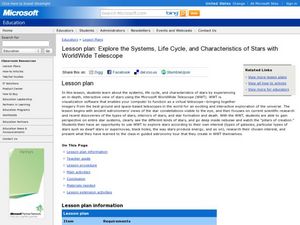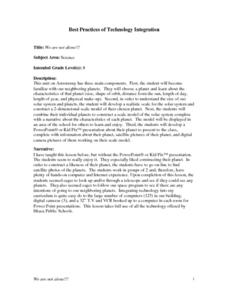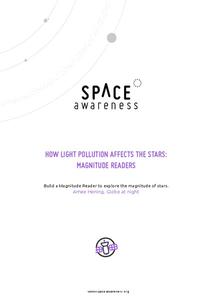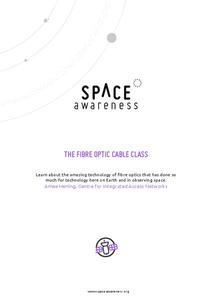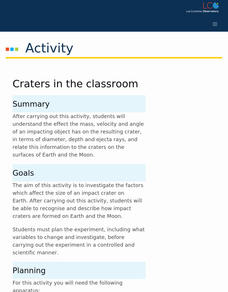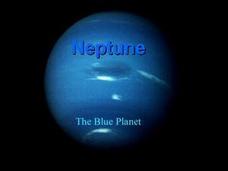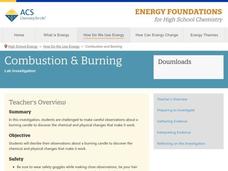Curated OER
The Reasons for the Season
Students explain the reason for the changes in season. For this lesson examining the relationship between the Earth and the Sun, students use an applet to discover how the alignment of the Earth and the Sun cause the change in seasons.
Curated OER
Explore the Characteristics of Stars with Microsoft WorldWide Telescope
Students explore the characteristics of stars. In this space science activity, students use the Microsoft WorldWide Telescope program to identify the properties of stars and identify the stars in the galaxy.
Curated OER
We Are Not Alone!!!
Eighth graders explore the area of astronomy. They explore Earth's neighboring planets. Students research a planet's characteristics. They develop a scale model of the solar system and a narrative about the planets.
Alabama Learning Exchange
The Solar System
Students explore the Solar System. In this cross-curriculum space instructional activity, students identify the planets, name them in order according to distance from the sun, and describe major characteristics of each planet. Students...
Curated OER
Sun Activity
In this space science worksheet, students find the answers to the questions concerning the topic of the sun and they label the diagram for the sun.
Curated OER
The Space Shuttle and the Future
In this space shuttle worksheet, students review the different facts associated with the space shuttle and the space station. This worksheet has 23 true or false questions.
Curated OER
Artificial Satellites and Space Probes
In this satellites worksheet, students match the list of facts given with the artificial satellite or space probe that it describes. This worksheet has 12 matching questions.
Curated OER
Early Space Missions
In this space missions instructional activity, learners read about the launch of the space shuttle Magellan and its exploration of Venus. Students complete 2 short answer questions based on the reading.
Curated OER
Space Exploration - Boom or Bust?
In this space exploration learning exercise, students will label if 5 statements support space exploration or not. Then students will complete 2 short answer questions giving their opinion about three things that are good and three...
Curated OER
The Earth, Sun Mood and Stars Unit (Planets too!)
Fifth graders prepare five activities to do then show their energy saving skills. In this investigative lesson students create five projects then participate in an energy saving demonstration.
Curated OER
GED Vocabulary: Earth and Space Science-Earth's Crust and The Solar System
In this earth and space science worksheet, learners complete a crossword puzzle given 9 clues and a word bank on topics such as sea floor spreading, tectonic plates, faults, lava and the big bang theory.
Curated OER
The Path to Mars
Students compare the similarities between both Earth and Mars. In this space lesson students use the Internet for research and to obtain geographical pictures of both planets. Students then analyze the pictures of both planets and...
Curated OER
GED Vocabulary: Earth and Space Science
In this earth and space science GED worksheet, students complete a crossword puzzle given 7 clues about topics such as earthquakes, the Milky Way Galaxy and weathering and erosion. Students are given a word bank to use to complete the...
Space Awareness
Measure the Solar Diameter
Scientists could measure the diameter of the sun before they knew its distance. Scholars construct a simple mirror box to measure the diameter for themselves. They compare this measurement with the official size, listed in a...
Virginia Department of Education
Weather Patterns and Seasonal Changes
Get your class outside to observe their surroundings with a lesson highlighting weather patterns and seasonal changes. First, learners take a weather walk to survey how the weather affects animals, people, plants, and trees during...
Space Awareness
How Light Pollution Affects the Stars: Magnitude Readers
Did you know light can decrease visibility? Light pollution absolutely makes it more difficult to see stars. Scholars build a simple magnitude reader to determine the magnitude of stars. They use these data to estimate the impact of...
Space Awareness
Navigation in the Ancient Mediterranean and Beyond
Ancient texts, like Homer's Odyssey, mentions navigating ships by observing constellations. Pupils learn about the link between history and astronomy as they relate to navigation in the Bronze Age. Scholars complete two hands-on...
Space Awareness
The Fibre Optic Cable Class
Many people know that fiber optics are used in delivering the Internet, but are surprised to learn they are also used in astronomy. Scholars explore light, reflection, and fiber optics through hands-on activities. They discuss...
Space Awareness
Meet Our Neighbors: Sun
The sun isn't just a ball of yellow! Young scientists learn about the features of the sun using a hands-on modeling activity. They build models of the sun using common household items to represent sunspots, solar prominence, and the...
Space Awareness
Let's Break the Particles
Build learning by breaking atoms! Young scientists study the way energy changes with a hands-on activity. As they roll steel marbles down a ramp, learners test the hypothesis that kinetic energy does not go away with friction...
McGraw Hill
Lunar Phases Interactive
View the moon changes from space while simultaneously experiencing the changes on Earth. A creative lesson allows pupils to view the big picture as they watch the orbit of the moon through a calendar period. At the same time, they see...
Las Cumbres Observatory
Craters in the Classroom
Laws of motion apply both in space and on Earth. Young experimenters model object impact on the Earth and moon. They use data to determine the effect mass and velocity have on the resulting craters and how that relates to the energy of...
Curated OER
Neptune: The Blue Planet
A lovely space science PowerPoint teaches learners about the discovery and characteristics of the planet Neptune. The slides show real photographs, along with clear descriptions about Neptune. This PowerPoint is beautifully done with...
American Chemical Society
Combustion and Burning
On Earth, a candle flame points up, but on the International Space Station, it forms a sphere. Young scientists practice their skills by recording observations before, during, and after a candle burns. Chemical and physical...
Other popular searches
- Space Science on Earth
- +Earth and Space Science
- Earth Space Science Quiz
- Inquiry Earth Space Science
- Earth and Space Sciences
- Science Earth and Space
- Earth Space Sciences
- Earth/space Science

